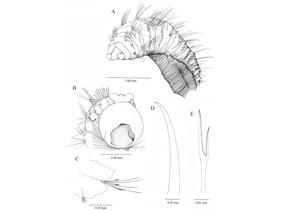You are here
Taxonomy
Oligobregma pseudocollare Schüller & Hilbig, 2007
Nomenclature
-
Family: ScalibregmatidaeGenus: Oligobregma
SUMMARY
The species is up to 10 mm long and 1.5 mm wide for more than 29 chaetigers. Its colour in alcohol is white to a light tan. The body is expanded in anterior region through segment 16–18, becoming narrow toward posterior end (Fig. 2A).
The prostomium has 2 rounded lobes projecting from anterolateral margin and no eyes; nuchal organs are also not apparent. The peristomium is well developed, forming 1–2 achaetous rings lateral to prostomium; the proboscis is smooth and saclike (Fig. 2B). Chaetigers 1–3 are more or less smooth, following segments becoming rugose; while anterior chaetigers are tri- to quadriannulated, from chaetiger 10 5 annulations are present (Fig. 2A). Anterior parapodia present themselves as reduced to simple lobes; medial and posterior parapodial lobes becoming more distinct, conical, with short conical dorsal and ventral cirri (Fig. 2C); interramal sense organs are apparent between posterior noto- and neuropodia. Chaetigers 1 and 2 with strong, sickle-shaped acicular spines in notopodia in addition to capillaries; the spines are always arranged in 2 rows and have a smooth surface (Fig. 2A, D); all other noto- and neuropodia carry capillaries; additional short furcated chaetae are present in both rami from chaetiger 3, these are covered by fine hairs; their tynes are unequal in length, short tyne about half of long one (Fig. 2E). The pygidium is positioned terminal; unknown for adult types; juvenile pygidium trilobate, without cirri.
Holotype: Scotia Sea northeast off Elephant Island, Sta. 46-7, 30 January 2002, 60°38.35’S, 53°57.36’W, 2889–2892 m, EBS (ZMH, P-24733)


